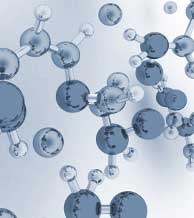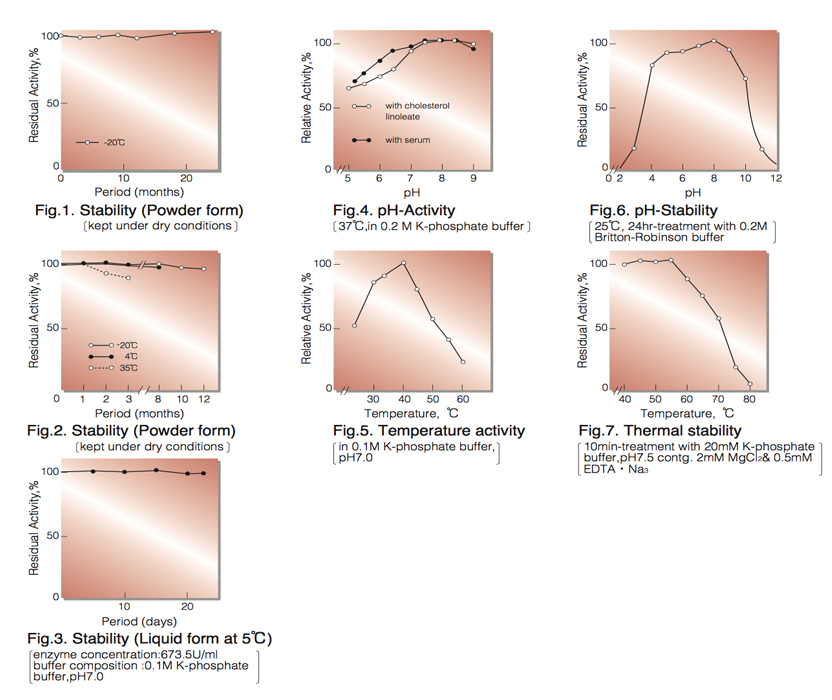CHOLESTEROL ESTERASE from Pseudomonas sp.
COE-311
Steryl-ester acylhydrolase (EC 3.1.1.13)

| Appearance: | Light brown amorphous powder, lyophilized | |
|---|---|---|
| Activity: | GradeIII 100U/mg -solid or more (containing approx. 40% of stabilizers) |
|
| Contaminant: | Catalase ≤1.0×10⁻²% | |
| Stabilizers: | Mg⁺⁺, Na-cholate, BSA | |
| Stability: | Stable at -20°C for at least One year (Fig.1) |
|---|---|
| Molecular weight: | approx. 300,000 |
| Isoelectric point: | 5.9±0.1 |
| Michaelis constants: | 5.4×10⁻⁵M (Linoleate), 6.6×10⁻⁵M (Oleate), 3.7×10⁻⁵M (Linolenate), 1.5×10⁻⁴M (Palmitate), 1.2×10⁻⁴M (Myristate), 2.3×10⁻⁵M (Stearate) |
| Inhibitors: | Hg⁺⁺, Ag⁺, ionic detergents |
| Optimum pH: | 7.0-9.0(Fig.4) |
| Optimum temperature: | 40℃(Fig.5) |
| pH Stability: | pH 5.0-9.0 (25℃, 24hr)(Fig.6) |
| Thermal stability: | below 55℃ (pH 7.5, 10min)(Fig.7) |
| Substrate specificity: | (Table 1) |
| Effect of various chemicals: | (Table 2) |
APPLICATIONS
This enzyme is useful for enzymatic determination of total cholesterol when coupled with cholesterol oxidase (COO-311, COO-321,COO-331) in clinical analysis.
ASSAY
Principle:
cholesterol esterase
Cholesterol ester+H₂O ►Cholesterol+Fatty acid
cholesterol oxidase
Cholesterol ►Cholest-4-en-3-one+H₂O₂
peroxidase
2H₂O₂+4-Aminoantipyrine+Phenol ►Quioneimine dye+4H₂O
The appearance of quinoneimine dye formed when coupled with 4-aminoantipyrine and phenol is measured at 500nm by spectrophotometry.
Unit definition:
One unit causes the formation of one micromole of hydrogen peroxide (half a micromole of quinoneimine dye) per
minute under the conditions described below.
Method:
| A. 0.2M K-Phosphate buffer, pH 7.0 |
|
|---|---|
| B. Cholesterol linoleate solution: | To 39mg of cholesterol linoleate, add 2.0ml of isopropanol and dissolve completely by heating slightly. Mix with about 80ml of 1.0% (v/v) hot Triton X-100 solution (preheated at 72~74℃) to the cholesterol linoleate solution and keep the solution in a hot water bath (72~74℃), stirring for 30 minutes. The solution will turn clear and then cloudy. Cool under running water with gentle agitation until temperature of the solution goes down to room temperature. Add 600mg of Na-cholate and dissove. Fill up the solution to 100ml with 1.0% Triton X-100 solution. This solution is stable at 4℃ for at least 5 days. |
| C. 4-AA solution: | 1.76% (1.76g 4-aminoantipyrine/100ml of H₂O)(Store at 4℃ in a brownish bottle) |
| D. Phenol solution: | 6.0% (6.0g phenol/100ml of H₂O)(Store at 4℃ in a brownish bottle) |
| E. POD solution: | Horseradish peroxidase (Toyobo, GradeIII) 7,500 purpurogallin units/50ml of 0.1M K-phosphate buffer, pH 7.0 (150PU/ml)(Prepare freshly) |
| F. COD solution: | Streptomyces sp. cholesterol oxidase (Toyobo, GradeIII) 1,500U/5.0ml of ice-cold H₂O (300 U/ml)(Should be prepared fresh) |
| G. Enzyme diluent: | 20mM K-phosphate buffer, pH 7.5 containing 2mM MgCl₂, 0.5mM EDTA-Na₃ and 0.2% BSA |
Procedure
| Concentration in assay mixture | |
|---|---|
| K-Phosphate buffer | 0.11 M |
| Cholesterol linoleate | 0.20mM |
| 4-Aminoantipyrine | 1.5 mM |
| Phenol | 22 mM |
| EDTA | 17 µM |
| Isopropanol | 0.68 % |
| COD | ca.10 U/ml |
| POD | ca. 5.1U/ml |
1. Prepare the following working solution (50 tests) in a brownish bottle.
75ml Buffer solution (A)
50ml Substrate solution (B)
2.5ml 4-AA solution (C)
5.0ml Phenol solution (D)
5.0ml POD solution (E)
(This solution is stable at 4℃ for at least 5 days.)
2. Pipette 2.75ml of working solution into a cuvette (d=1.0cm) and equilibrate at 37℃ for about 5 minutes. Add 0.1ml of COD solution (F), mix and keep at 37℃ for another 2 minutes.
3.Add 0.1ml of the enzyme solution* and mix with gentle inversion.
4. Record the increase in optical density at 500nm against water for 3 to 4 minutes in a spectrophotometer
thermostated at 37°C, and calculate theΔOD per minute from the initial linear portion of the curve (ΔOD test).
At the same time, measure the blank rate (ΔOD blank) using the same method as the test except that the enzyme diluent (G) is added instead of the enzyme solution.
* Dissolve the enzyme preparation in ice-cold enzyme diluent (G), and dilute to 0.08-0.22U/ml with the same buffer, immediately before assay.
Calculation
Activity can be calculated by using the following formula :

ΔOD/min (ΔOD test−ΔOD blank ) × Vt × df
Volume activity (U/ml) = =ΔOD/min×4.282×df
13.78×1/2×1.0×Vs
Weight activity (U/mg) = (U/ml) × 1/C
- Vt
- : Total volume (2.95ml)
- Vs
- : Sample volume (0.1ml)
- 13.78
- : Millimolar extinction coefficient of quinoneimine dye under the assay conditions(㎠/micromole)
- 1/2
- : Factor based on the fact that one mole of H₂O₂ produces half a mole of quinoneimine dye
- 1.0
- : Light path length (cm)
- df
- : Dilution factor
- C
- : Enzyme concentration in dissolution (c mg/ml)
REFERENCES
- C.C.Allain, L.S.Poon, C.S.G.Chan, W.Richmond, and P.C.Fu; Clin.Chem., 20, 470 (1974).
- Y.Kameno, N.Nakano, and S.Baba; Jap.J.Clin.Path., 24, 650 (1976).
| Cholesterol ester | Relative activity (%) | Cholesterol ester | Relative activity (%) | ||
|---|---|---|---|---|---|
| Linoleate | (18 :2) | 100 | Tridecanoate | (13 :0) | 53.3 |
| Acetate | (2 :0) | 2.9 | Myristate | (14 :0) | 49.3 |
| Propionate | (3 :0) | 21.3 | Pentadecanote | (15 :0) | 46.6 |
| Crotonate | (4 :1) | 0.0 | Palmitate | (16 :0) | 33.5 |
| Valerate | (5 :0) | 8.0 | Heptadecanoate | (17 :0) | 0.0 |
| Caproate | (6 :0) | 17.3 | Stearate | (18 :0) | 8.0 |
| Heptanoate | (7 :0) | 18.6 | Oleate | (18 :1) | 105.3 |
| Caprylate | (8 :0) | 58.6 | Linolenate | (18 :3) | 166.5 |
| Nonanoate | (9 :0) | 48.0 | Phenyl acetate | 0.0 | |
| Decylate | (10 :0) | 40.0 | Cinnamate | 0.0 | |
| 10-Undecenoate | (11 :1) | 114.6 | Benzoate | 58.6 | |
| Laurate | (12 :0) | 54.6 | |||
Number of carbon atoms and number of double bonds are given in parenthesis.
| Chemical | Concn.(mM) | Residual activity(%) |
Chemical | Concn.(mM) | Residual activity(%) |
|---|---|---|---|---|---|
| None | − | 100% | MIA | 2.0 | 96 |
| Metal salt | 2.0 | NaF | 20.0 | 99 | |
| CaCl₂ | 96 | NaN₃ | 20.0 | 100 | |
| Ba(OAc)₂ | 100 | EDTA | 5.0 | 100 | |
| FeCl₃ | 87 | o-Phenanthroline | 2.0 | 100 | |
| CoCl₂ | 97 | α,α'-Dipyridyl | 2.0 | 99 | |
| MnCl₂ | 88 | Borate | 20.0 | 100 | |
| Zn(OAc)₂ | 83 | Triton X-100 | 1.0% | 97 | |
| NiCl₂ | 99 | Brij 35 | 1.0% | 100 | |
| Pb(OAc)₂ | 95 |
SDS | 0.1% | 8 | |
| AgNO₃ | 51 | Na-cholate | 1.0% | 100 | |
| HgCl₂ | 14 | Taurocholate | 0.1% | 100 | |
| NEM | 2.0 | 100 | |||
| PCMB | 2.0 | 100 |
Ac, CH₃CO; NEM, N-Ethylmaleimide; PCMB, p-Chloromercuribenzoate; MIA, Monoiodoacetate;
EDTA, Eth-ylenediaminetetraacetate; SDS, Sodium dodecyl sulfate.

To get a quote, contact us at info@toyobousa.com, or INQUIRY.